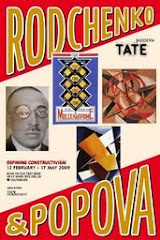Constructivism comes from the Russian Konstruktor which means: ‘the one who constructs’
So in Russian ‘constructivism’ is synonymous with engineering1.
The engineer is concerned with the production of utilitarian objects and in this case these utilitarian objects are propaganda based on scientific principles.
The word construction in English looses this close association with engineering.
Images were constructed using the compass and ruler;
Emotional and stylistic qualities were seen as obsolete – in an essay called ‘The Line’ Rodchenko describes the brush as an insufficient and imprecise instrument that could be surpassed by the ruler and ruling pen;
In this sense scientific rational principles were used in opposition to traditional forms of artistry which relied on inspiration2; different brush strokes were rejected in favour of ‘The Line’; and traditional artistic skills were rejected in favour of mass propaganda.
In short this is the rationalisation of the creative processes and impulses and art education was governed based on scientific principles designed to teach the artist to produce predictable and measurable effects in the viewer. (SLIDE 1)
Kandinsky was the first president of INKhUK (the Institute for Artistic Culture).
He drew up a catalogue which documented the psychological effects of foundational visual elements.
The Institute then established a psychological laboratory in mid 1920 to further develop these ideas and it produced a ‘dictionary of visual effectiveness’.
This was the development of a ‘science of art’, exerting an organising influence on the psyche by means of emotional control of the perceptions.
For instance the whole range of colours, shapes and elemental forms were systematically measured according to their psychological effect, and this study was based on scientific work dating from at least since the second half of the Nineteenth Century.
These concepts were to be disseminated by artists.
Tretykov, head of the VKhUTEMAS, explains that the revolution had put forward a new practical task for artists whereby they were required by the state to ‘affect mass psyche and to organise the will of the classes’.
In 1921 the Institute for Artistic Culture engaged in a discussion about how to turn artists into constructivists or engineers. They were taught how to use modern engineering methods based on the rigorous scientific study of the human psyche, industrial design and mass propaganda intended to scientifically control the perceptions of the masses.
Originally visual works contained measurable and calculated simple forms, but gradually they became to be composed only of these aspects.
Rodchenko, for instance, describes the reduction of painting to its logical conclusion- a common sentiment based on an evolutionary telos. (SLIDE 2)
The ruler and compass represent the mathematical systematic use of simple form. Geometric forms were therefore ideal for controlling response in the viewer, the imagery itself being based on (at least) decades of investigation into the psychology of perception and scientific aesthetics.
In the 1920’s Soviet Russia aimed to create a mass psychological culture, 3 it was one of the most extreme behaviourist experiments to be so openly and rigorously scientifically documented and was designed not just to control consumer habits (as in the west), but also to systematically engineer and control the consciousness of the whole society.
Apart from the Institute for Artistic Culture there were a number of psychological labs set up in various art institutions such as the VKLUTEMAS, GAKLN and the State Institute of Artistic Culture.
Their goal was the ‘fully rationalised visual language of mass communication’ whereby ‘each element was capable of communicating a meaning, producing an emotion and causing a behavioural response’4 (SLIDE 3)
Rodchenko developed a visual language whereby each elemental abstract form would produce a completely predictable response in the audience.
Under his presidency the Institute for Artistic Culture pursued a systematic study of the ways in which the masses could be controlled through perception of visual form5.
Art was to be the ‘organisation of life’6, (SLIDE 4) and the bringing of ‘Art into Life’ (SLIDE 5) was articulated by using three dimensional designs and effecting the ‘flow of the crowds’ by using architecture based on geometrical form.
What was being engineered? (SLIDE 6)
The Institute for Artistic Culture tells us that it is the psycho physical human consciousness7 that is being engineered.
Architecture, mass spectacles, posters, designs, photomontages etc were designed to produce ‘calculated bodily responses, emotions and meanings in the viewer’8
To shape the human being as an organised unit9 under a single State authority.
The goal was the development a new society. This new society could only progress or change if the individual units of the whole were altered. Therefore to transform the society the state had to manage the behaviour of the individual, hence the emphasis on scientific behaviourism, sexless and geometric working clothes (SLIDE 7) and standardised architectural designs for buildings etc.
This is always based on an evolutionary model whereby diversity is reduced to unity and fixity, and individual different apperceptions of form are reduced to standardised norms.
In this sense artistic inspiration, expression and individuality etc became standardised by means of the compass and rule, number and line.
References:
Lodder, C (1983) Russian Constructivism.
All INKhUK quotes from Manovich, L (??) The Engineering of Vision: From Constructivism to Computers
The Tate Modern: Rodchenko and Popova: Defining Contructivism
1 Monivich p.156
2 Manovich p.156
3 Manovich p.23
4 Manovich p. 8
5 Manovich p.153
6 Lodder p.109
7 Versin at INKhUK
8 Manovich p.156
9 INKhUK – ‘Engineerism’
Thursday, 30 April 2009
Subscribe to:
Post Comments (Atom)

No comments:
Post a Comment